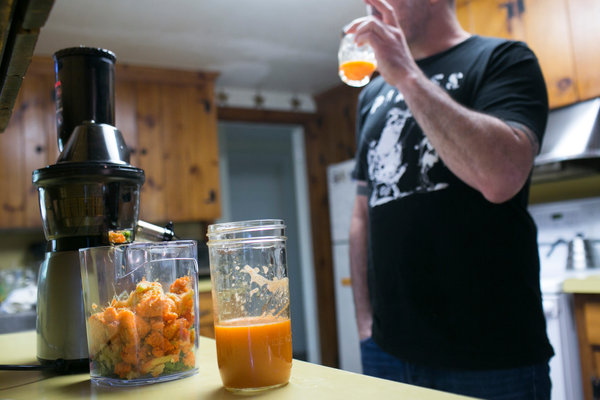
Cereal, that bedrock of the American breakfast, has lost some of its snap, crackle and pop.
For the last decade, the cereal business has been declining, as consumers reach for granola bars, yogurt and drive-through fare in the morning. And the drop-off has accelerated lately, especially among those finicky millennials who tend to graze on healthy options — even if Cheerios and some other brands come in whole-grain varieties fortified with protein now.
As a child, Adam Feuerstein started his day with a homemade breakfast. “Growing up, I would combine Frosted Flakes and Cap’n Crunch,” said Mr. Feuerstein, a financial reporter at The Street. “I have such vivid memories of it that if I walk down the cereal aisle today, I still gravitate toward those cereals.”
Cereal companies have tried to play on that nostalgia, with commercials featuring generations of Cheerio eaters or couples fighting over the marshmallows in Lucky Charms.
But Mr. Feuerstein, who is 46, isn’t buying the sales pitch. These days, he eats breakfast around 10 or 11 in the morning, preferring juice he makes himself. If he eats cereal at all, it is a Trader Joe’s private label version “as a treat,” he said.

“You realize that it’s just a sugar delivery vehicle,” he said of cereal. “We’ve all gotten a little smarter about the foods we eat, and while there are plenty of healthy cereals out there, I just don’t choose to eat much cereal.”
Cereal consumption peaked in the mid-1990s, according to the NPD Group, a consumer research firm. Still, some 90 percent of American households report buying ready-to-eat cereal, which remains the largest category of breakfast food with some $10 billion in sales last year, according to Euromonitor, down from $13.9 billion in 2000. And the consumer research firm estimates sales will fall further this year to $9.7 billion.
“More and more consumers are eating breakfast,” said Noel Geoffroy, senior vice president for morning foods marketing and innovation at the Kellogg Company. “The absolute market is growing — and along with that, so are the choices of what consumers eat for breakfast.”
Cereal sales have long been subject to dips brought on by food fads like the Atkins diet or bagel mania. And many cereals are neither gluten-free nor protein-rich, so they fail to resonate with the growing number of consumers who are gluten-intolerant or adherents of the so-called paleo diet.
But investment analysts say the current slump is a result of more pernicious trends. “The common observation by a lot of companies facing declining cereal sales is that this is a kind of death by a thousand cuts,” said Nicholas Fereday, an investment analyst specializing in food and agriculture at Rabobank and author of a report, “The Cereal Killers: Five Trends Revolutionizing the American Breakfast.” “This is frustrating for food companies because they’re faced with people making choices and they’re not really sure which trend to blame.”
Mr. Fereday noted, for instance, that the birthrate was declining — and children traditionally have been the largest consumers of cereal. Other demographic factors are at play as well: Many surveys have shown that Latinos and Asians prefer other breakfast foods.
Cereal Sales Decline
Sales of cold beakfast cereals have fallen over the last decade, particularly for brands marketed to children.

Breakfast cereal sales
Change in consumption 2003-2013
FAMILY CEREALS
–5.5%
Flaked cereals
Including corn flakes, Raisin Bran, etc.
+1.8%
Muesli
Rolled-oat and granola-type cereals.
–3.4%
Other
Including puffed wheat, Cheerios, Life cereal, etc.
CHILDREN’S CEREALS
–10.7%
All types
Including Lucky Charms, Cocoa Puffs, etc.
And, of course, there are the millennials, those consumers between the ages of 14 and 32 who are proving to be a headache for food companies.
“They’re much more likely to be snacking rather than eating three meals a day, and therefore may not have a traditional breakfast at all,” said Jeff Fromm, president of FutureCast, a consumer research firm specializing in millennials. “Additionally, there’s a small but very active and influential group of millennials who are focused on health and don’t like processed food. Guess what, cereal companies? They want to kill you.”
As if those challenges were not enough, new kitchen gadgets make whipping up a smoothie or a custom blend of juices easy to do at home. Plus, a number of new fast-food breakfast options — waffle taco, anyone? — have put dents in cereal sales.
For example, Daniel Bjornson travels four days a week as a consultant, and he likes to eat cut fruit and toast with peanut butter while on the road. “If I’m just at home, it would be Greek yogurt,” he said. “I don’t dislike cereal, but yogurt just seems like a healthier option.”
About three months ago, he said, he bought a box of Kashi with added protein, an attribute that attracted him.
At General Mills, the company’s yogurt brands have eaten away at sales of its cereals, which include Lucky Charms, Cinnamon Toast Crunch and Cheerios. “Some of my business has definitely gone to my colleague running yogurt,” said Jim Murphy, president of Big G, General Mills’ cereals unit.

Big G has made tweaks in advertising and ingredients to address changing consumer preferences. For instance, it continues to reduce sugar in its cereals, and it pulled Nature Valley cereals out of mothballs and added protein to them in 2013.
It also found a way to capitalize on Chex, which had produced consistent sales but little growth since General Mills acquired it in the 1990s. “We had tried everything to move the needle: new advertising, new flavors — and then we marketed it as gluten-free, and it took off,” Mr. Murphy said.
General Mills also is marketing its iconic cereals as family brands in an appeal to nostalgia: Adults account for almost half of the consumption of Cinnamon Toast Crunch, for instance.
Such changes have kept the company’s sales of cereals stable at a time when its competitors are struggling. This month, Post Holdings reported that sales of its cereals, which include Alpha-Bits and Grape-Nuts, were down 3.4 percent in the fiscal third quarter compared to the same period last year, while sales of morning foods at the Kellogg Company, which includes Pop-Tarts, breakfast bars and beverages in addition to its cereal brands, slid 4.9 percent in the second quarter.
John A. Bryant, the chief executive of Kellogg, was characteristically blunt in explaining the decline to investment analysts on July 31. “The overall decline has been largely due to innovation that hasn’t worked,” Mr. Bryant told them, citing disappointing sales of Mini-Wheats Crunch, now discontinued, as well as efforts to alter its FiberPlus and Crunchy Nut brands.
The executive who had been in charge of Kellogg’s cereal business for eight months left the company and was replaced by his predecessor. Kellogg’s also brought back David Denholm from Chobani to run its faltering Kashi brand, which he had previously overseen, and the company said it would move the business back to La Jolla, the San Diego community where it was founded.

Kellogg’s has added protein to Kashi GoLean and Special K, a move that Ms. Geoffroy, the marketing executive, said was working well, and it has begun packaging its staple cereals for children, like Froot Loops, Apple Jacks and Corn Pops, in pouches to make them more convenient for mothers to use as snacks.
MOM Brands, formerly Malt-O-Meal, has so far been immune to the trends buffeting the rest of the industry; two years ago, it surpassed Post to become the third-largest cereal maker, largely with simple innovations.
“Over the last 10 years or so, as the category has been going down, we’ve doubled our market share,” said Paul Reppenhagen, senior vice president for marketing and corporate strategy. “We’ve had 5 percent compound annual growth over the last five years.”
About that time, it began a campaign it called “bag the box,” eliminating the box from its cereals to reduce packaging, which resounded with the environmental crowd (though it once again is boxing some of its products).
The company also periodically offers “price buster bags,” selling its Malt-O-Meal cereals in 11-ounce pouches for $1 to drive sales. It also offers 13 to 15 ounces of its cereals at an everyday price of $2. “These are great value, particularly for those consumers who get to the end of the month and are strapped for cash,” Mr. Reppenhagen said.
MOM, which is owned by the descendants of its founder, John Campbell, also has had success with a relatively new brand, Mom’s Best cereals, “because of an absence of negatives,” Mr. Reppenhagen said. “No hydrogenated oils, no preservatives, no artificial flavors and colors — we even use vegetable dyes in the packaging.”
All of those changes, however, would not make a difference to Megan Scott, an account executive at Trozzolo, an advertising and public relations firm in Kansas City, Mo. “I really value my sleep, so typically I won’t wake up any earlier to eat breakfast,” Ms. Scott said.
She could not remember the name of the cereal she had eaten as a child, and as a teenager, her mother handed her and her brother cans of Carnation Instant Breakfast drink just to get them to eat something with nutrition in it.
Ms. Scott said she liked breakfast, but simply didn’t have time for it. So her morning menu is a cup of coffee.
“I hope that breakfast will become a meal for me,” she said. “I feel like it should be, but right now, convenience is more important.”